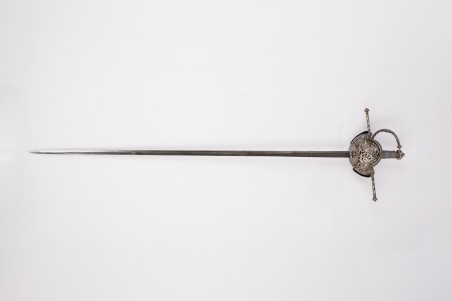FRETTED AND CHISELLED SPANISH CLOVERLEAF TIZONA. 17th Century. Handcrafted in carbon steel.
The cup hilt sword, which had a knuckle guard, two straight quillons forming a cross with the blade, and a cup equipped with arms securing it on the inside, as well as a fretted plate in many instances, arose in the first half of the 17th century. In Spain and in the regions under its influence, the upper lip of the cup was folded outwards so that it could be used to break the point of the adversary’s sword.
In general, swords can be found with three different cup patterns: fretted, chiselled with decorative designs, and smooth, while the grip is always wire wrapped. Cup hilt sword production flourished in Spain and Italy until the 18th century.
The blades of 17th century swords usually featured one or more fullers in the forte section of the blade, where the swordsmith’s name, the place it was made and, sometimes, the date were engraved. The number of bevels varied, and some have oval cross sections while others are diamond-shaped. In the second half of the century, a long, narrow, blade called a verduguillo, with a square or triangular cross section, became popular.
With rapiers, wielders continued to face each other when fighting, unlike later fencing with court swords and foils, in which they began to turn sideways in relation to the adversary. As a single-hand sword, agility and speed took precedence over brute force. The placement of the feet and sideways movements were also important.
Pointed rapiers afforded greater speed in the attack, making them the preferred sword for duelling. The swiftness with which it was possible to go from a defensive stance (blocking) to an offensive one (thrusting) was remarkable, and greatly influenced fighting techniques.
If a pointed “civilian” rapier were to face off against a “military” rapier with a sharp edge and point, the former would have the advantage of speed, but since it was not as strong, whenever possible, the wielder of the civilian rapier would attempt to deflect the latter’s attack rather than to block it with his sword. At any rate, it was advisable to use the strongest part of the blade (the forte) for blocking.
The rapier is the quintessential sword of the 16th and 17th centuries. During the 16th century in Europe, swords became less prevalent as the primary weapon of war, while their use as secondary weapons for personal defence rose. On the other hand, their use as a civilian weapon in affairs of honour and street brawls (hitting targets) became widespread. They were also used for less serious purposes, as a fashion accessory for the bourgeoisie and noblemen.
CHARACTERISTICS
BLADE. 96 cm long blade, 2 cm wide at the ricasso and 0.5 cm at the point. It is completely forged and tempered by hand by the distinguished artisan Juan Ricas de Toledo.
Both sides of the ricasso bear the artisan’s touchmark, and a deep fuller characterises the first quarter of the blade, with an inscription on both sides. Below that, the blade is divided into four highly pronounced bevels, two on each side of the slender, very light-weight, but strong, blade.
CUP OR CAZOLETA. The cup is shaped like a four-leaf clover covered in fretted and chiselled Renaissance style motifs. Only a highly skilled artisan would be capable of executing such meticulous work. There is a point-breaker on the outside of the clover, decorated with chiselled volutes. There is a round piece with similar chiselling and fretwork inside the clover-shaped cup.
CROSS GUARD. The cross guard features a 29 cm long quillon made of grooved and twisted engraved iron with a small chiselled ball at the tips. The knuckle guard that curves toward the pommel also bears the same design as the quillon. Two semi-circular side arms attach the cross to the cup. At the centre of the main quillon, as mask has been chiselled on both sides.
GRIP. The wood grip is wrapped in a braided steel wire cord alternating with several simple steel wires, and two multiple intertwined cords act as ferrules at the ends of the grip. It is threaded on the blade tang.
POMMEL. The grooved and engraved pommel in the shape of a crown has a ball at the top and is threaded onto the blade tang to make the sword stronger and sturdier.
Unique piece.
CRAFTSMANSHIP OF TOLEDO. SPAIN.
Elaborately fretted and chiselled Spanish cloverleaf Tizona ES733. Handmade. Unique piece
ES733
Last items in stock
€19,000.00
Tax included
Transport: Shipment with insurance
Description
Product Details
- Blade size
- 96 cm
- Total size
- 116 cm
- Weight
- 1.272 gr
- Ratio
- 21.40
1 Item














































